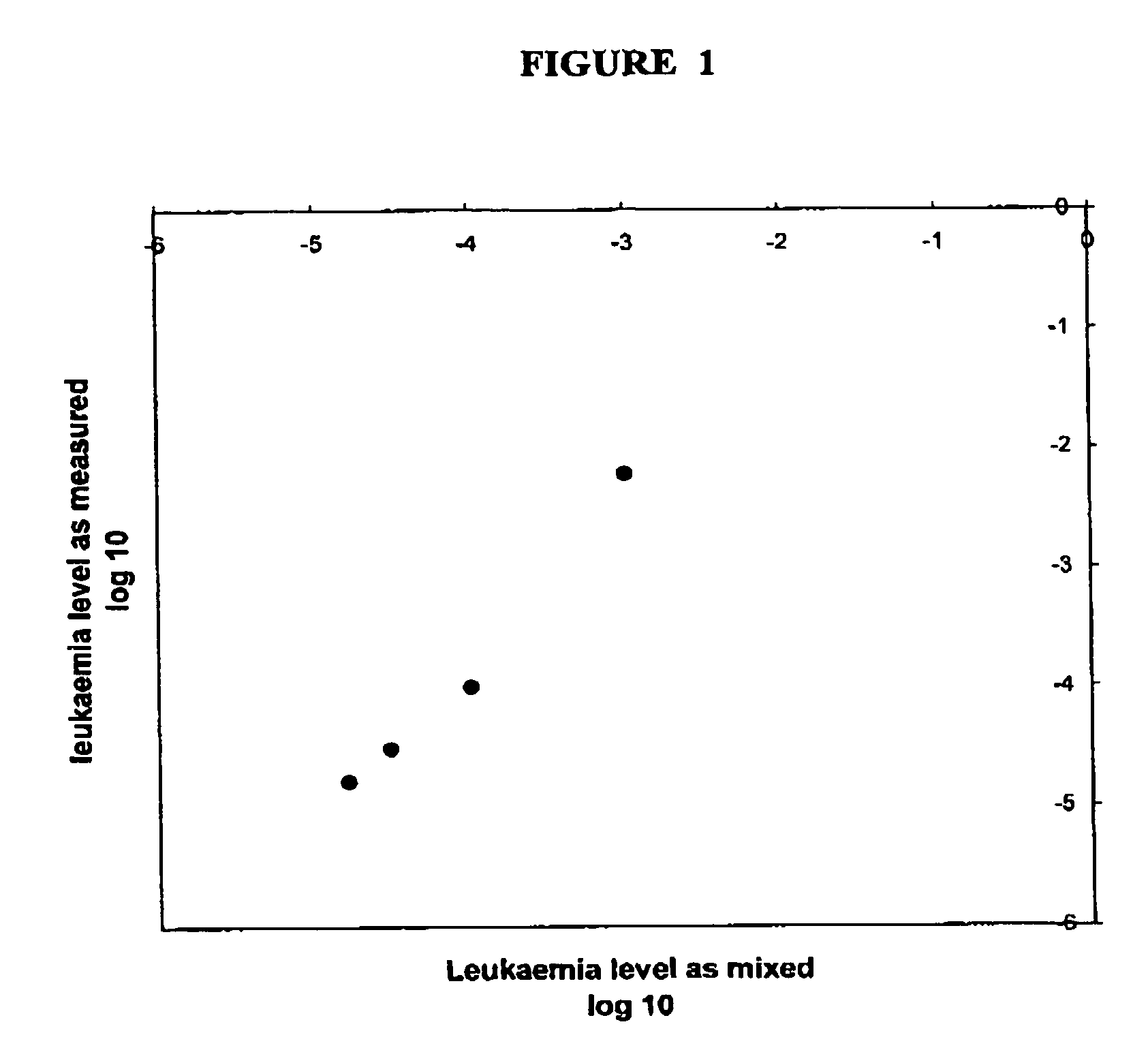Method of analysing a marker nucleic acid molecule
a nucleic acid molecule and nucleic acid technology, applied in the field of nucleic acid region characterisation, can solve the problems of difficult detection of signal from target molecules, relatively problematic procedure of clonal population of cells or organisms in subjects, etc., and achieve the effect of facilitating amplification of flanking sequences
- Summary
- Abstract
- Description
- Claims
- Application Information
AI Technical Summary
Benefits of technology
Problems solved by technology
Method used
Image
Examples
example 1
Schematic Flow Chart to Illustrate Quantification of Leukaemia During Treatment
[0113]Starting material—polyclonal population of lymphocytes, containing clones of various sizes ranging from 1 to very many cells[0114]each clone characterised by 1 of >50 V segments, 1 of >30 D segments and 1 of 6 J segments[0115]leukaemic clone for analysis has unknown V, D and J segments (say for argument V23, D7 and J4)[0116]Using leukaemic cells at diagnosis as a relatively pure clonal population[0117]determine flanking J, V and D segments (J4, V23 and D7 in this case).[0118]Analyse above starting material[0119]Amplification reaction on starting material with V23 and J4 primers [0120]Amplification reaction on V23 and J4 amplified material with D7 and J4 primers [0121]Amplified material is largely or wholly derived from only those clones characterised by V23, D7 and J4. It is thus greatly enriched for material derived from the leukaemic clone. [0122]Analyse marker region of amplified material by quan...
example 2
Protocol for Identifying J, V, D Regions
J Screen
[0125]taqman probe MJB2[0126]use 10 ng diagnostic DNA per tube with each tube in duplicate[0127]3A-J1, J1dup, J2, J2dup, . . . J6, J6dup[0128]28 tubes including controls[0129]perform quantitative PCR using file 92C for 15 seconds, 58C for 1 minute×45 cycles[0130]run relevant tracks on gel to verify size[0131]A Ct around 27-35 cycles indicates the J region for a dominant clone
Once have identified specific Jregion do V screen
V Screen[0132]taqman probe MJB2[0133]use 10 ng diagnostic DNA per tube with each tube in duplicate[0134]Vspecific (41 primers)-Jspecific[0135]90 tubes including controls[0136]perform quantitative PCR using file 92C for 15 seconds, 58C for 1 minute×45 cycles[0137]run relevant tracks on gel to verify size[0138]A Ct around 25-30 cycles indicates the V region for a dominant clone
D Screen[0139]taqman probe MJB2[0140]use dilution of approx. 1 / 100,000 from Vspecific-Jspecific in V screen as template[0141]Dspecific (31 prime...
example 3
Quantification of Leukaemia Using Primers Binding to Flanking Sequences
[0151]Results of quantification of leukaemia using primers binding to the flanking sequences, as shown schematically in Example 1, and with the flanking sequences and primers being identified by the protocol shown in Example 2. Leukaemic cells were mixed in known proportion with normal blood cells and the proportion of leukaemic cells in the mixture was then quantified using the Method. Each symbol shows the result from a different sample mixture. Note the close concordance between the “true” result, as inferred from the proportions in which the cells were mixed, and the measurement obtained by the Method.
Primers Currently in Use to Determine Flanking Sequences
VH Primers Specific for Individual Vh Segments
[0152]
SEQVhVhIDfamilyregionLocationSequence 5′ to 3′NO:12CDR2ATCAACCCTAACAGTGGTGG113CDR2GCTGGCAATGGTAACACAAAA218CDR2ACCTAACAGTGGTAACACAGG3118CDR2GGGATGGATCAGCGCTT4124CDR2TGGAGGTTTTGATCCTGAAGA5145CDR2ACACCTTTCAAT...
PUM
| Property | Measurement | Unit |
|---|---|---|
| nucleic acid | aaaaa | aaaaa |
| compositions | aaaaa | aaaaa |
| length | aaaaa | aaaaa |
Abstract
Description
Claims
Application Information
 Login to View More
Login to View More - R&D
- Intellectual Property
- Life Sciences
- Materials
- Tech Scout
- Unparalleled Data Quality
- Higher Quality Content
- 60% Fewer Hallucinations
Browse by: Latest US Patents, China's latest patents, Technical Efficacy Thesaurus, Application Domain, Technology Topic, Popular Technical Reports.
© 2025 PatSnap. All rights reserved.Legal|Privacy policy|Modern Slavery Act Transparency Statement|Sitemap|About US| Contact US: help@patsnap.com


